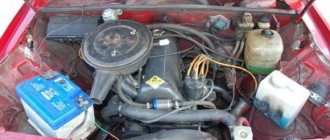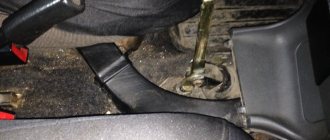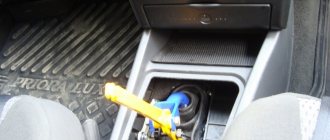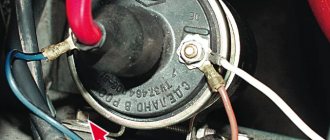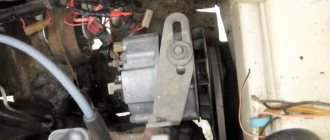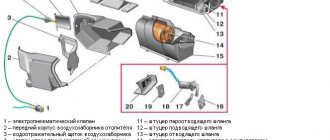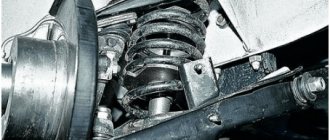A heating system that uses the heat of the coolant is responsible for heating the interior of the VAZ 2107. This scheme, recognized as optimal for cars with internal combustion engines, has been used in cars since the mid-20th century.
Like any car component, the VAZ 2107 stove may stop working. In winter, such a breakdown makes the car impossible to operate: the windows sweat or become covered with frost, which impairs visibility. For effective repairs, you need to have a good knowledge of the interior heating system.
Control mechanism
The control of the VAZ 2107 stove is mechanical. It consists of a fan switch and a block of sliders. The control mechanism is installed on the center console at the top, which provides easy access to the elements.
There are three sliders of the control mechanism, and each of them controls its own element:
- The top one is responsible for supplying antifreeze to the radiator and is connected by a cable to a tap installed on the inlet pipe. The extreme left position of the slider means the tap is closed (the stove does not heat), the right position means the tap is open (antifreeze enters the radiator).
- Middle – air supply damper control. When you move it to the left, the damper shuts off the air supply from the street (closed air circulation in the cabin), while the right position means the air flow is open (air from the street enters the cabin).
- The lower one controls the damper for distributing the flow through the air ducts. Left position - the flow is supplied through the side and central deflectors, right - to the windshield area. Each of these sliders can be adjusted to any position to achieve optimal stove operation.
The main problems of the stove
You can solve the problem of poor heating only if you know its weak points. Most often, the need to improve a unit arises for the following reasons:
- Leaking heating system faucet.
- Poor quality air supply.
- Low level of air flow from the deflector.
- Loud noise when the heating system is operating.
Thus, you can increase the temperature in the cabin in winter if you replace the faucet and deflector, troubleshoot the radiator, and upgrade the fan. These modifications are not difficult to do with your own hands, but they will significantly improve the quality of the heating system.
Principle of operation
The heating system works simply - to ensure air heating, the driver uses the upper slider to open the antifreeze supply valve to the heater radiator. If the air supply damper is open (the middle slider is in the extreme right position), then the air flow through the box that separates the moisture and the damper enters the stove body. Passing through the radiator, the air heats up, and then moves depending on the location of the remaining dampers.
If the lower slider is moved to the right, then the heated air will go to the windshield area, and if it is positioned to the left, it will go to the center of the cabin and to the side windows. To supply heated air to the feet, the driver needs to lower the lower damper lever down.
When driving at high speeds, the air flow through the air intakes moves intensively, so it is not necessary to turn on the fan. But if the movement speed is not enough, the fan creates forced circulation.
Using dampers and a fan, the driver controls the stove - sets the speed of air movement, the degree of its heating and the area of distribution.
How does the heater work?
The operating principle of the heating device is very simple. After opening the tap, the coolant begins to circulate through a large circuit and is supplied to the heater radiator. When the air intake damper is moved back, it passes into the radiator, where it heats up and is then sent to the passenger compartment.
If the car is driving fast, then the natural flow is enough for the stove to work well and effectively heat the cabin. In this case, the fan is not turned on. In other situations you cannot do without it.
Control module
The heating system of the VAZ-2107 is controlled using a special module located at the bottom of the dashboard. Its design includes three levers and a heater fan mode switch.
The topmost lever controls the “stove” tap. In the extreme left position it is closed, and the coolant flows bypassing the heating radiator. If the switch is moved all the way to the right, the refrigerant will begin to flow into it in full, heating the air to the maximum.
The middle lever allows you to close and open the air supply cover. In the left position it will be completely closed and outside air will not be able to enter the cabin. The lid will open completely when we move the switch to the far left position.
The heating system of the VAZ-2107 provides for the distribution of air flows for blowing the windshield and front side windows. This is done using the lower lever. In the right position, the air is directed to the side windows, in the left - to the windshield.
The heater valve, air supply cover, as well as dampers that redirect air flows are driven by cables.
The fan mode switch is located to the left of the control levers. It has four positions in which the fan:
- switched off;
- works at first speed;
- at second speed;
- at third speed.
An easy way to upgrade
The radiator on the VAZ-2107 gives off enough heat, so it should not be changed. The easiest way to tune is as follows:
- Replacement of standard model fan motor. It needs to be changed to the one used in the VAZ-2109, with more power and speed. It is larger in size, therefore, you will need to remove the comb that directs the air flow to the legs.
- Make a 7 mm hole in the impeller for the motor shaft. This will allow you to do without replacing it.
- From the VAZ-2109 you will need a resistor and a switch. These parts also need to be changed.
Pay attention to the last point, if you do not replace the resistor and switch, then all other actions will be in vain, since the VAZ-2107 switch operates at a lower current. Working with a powerful engine from the “nine” will melt it. If you leave the resistance from the “seven”, it will not allow the motor to work at full power.
Nozzles
A nozzle, or deflector, is a device through which air enters directly into the cabin. The heating system of the VAZ-2107 includes four deflectors: left, two central and right. A special feature of the nozzle design is a mechanism that allows you to change the position of the lamellas inside it, redirecting the air flow from side to side, and also block it altogether.
What is hidden under the panel in the car interior?
The “refrigerator effect” becomes most noticeable if you still continue to use old VAZ models with front-wheel drive: 2108, 2109, 21099. Let's try to figure out whether there is any possibility of replacing the heating system yourself. Despite the visual identity of the car models, there is still some difference in these VAZ units of the 8th and 9th models.
This difference is not fundamental. It’s just that in the process of evolution, unnecessary air ducts were removed from the design, the shape of the damper and the location of the radiator were changed. But this does not change the principle of operation. The interior is heated by air, a radiator connected to the engine cooling system is responsible for heating it, and the heater itself is located under the instrument panel in the car, which is higher in the VAZ 21099 due to some design features of the stove. With the help of connected air ducts, heat flows into the interior.
To force heated air into the cabin, a fan is located at the top of the heater, which rotates using an electric motor. The easiest way to access it is from the engine compartment. , which was mentioned above, is located in the VAZ 2109, 2108 and 21099 models near the heater itself. It has a seal in the form of a polyurethane foam gasket and consists of two plastic tanks, cooling plates and tubes arranged in two rows.
Since heating is connected to the car’s cooling system, fluid circulation through the radiator occurs using the pump of this system. You can regulate its flow using the heater tap and various levers that affect the position of valves and dampers. Warm air enters the cabin through two central and two side nozzles, inside of which there are dampers that regulate the intensity of heating. The direction of flow is also changed by blades-blinds using levers in the cabin.
After the air in the cabin is heated, it is necessary to circulate it and maintain the set temperature. It is necessary to release the waste stream outside. In this regard, on VAZ 2108 models, hot air flows out through holes located in the central body pillars. On 9-model cars, these holes are located in the corners of the rear side windows and have rubber valves that prevent atmospheric air from entering the air ducts.
Reasons for decreased performance
In addition to obvious malfunctions due to which the stove does not work or functions incorrectly, there are other problems with the heating system of the VAZ-2107 interior. The main one is a decrease in stove performance.
If the stove heats poorly, then the reason lies in:
- Malfunctions of the power plant cooling system (reduced pump performance, stuck thermostat).
- Radiator clogged.
- Formation of an air lock in the heater radiator.
- The air intake damper seal is worn out.
To find the cause of decreased performance, start by checking the heating of the heater radiator. To do this, heat the engine to operating temperature, fully open the antifreeze supply valve to the stove and hand check the degree of heating of the supply pipe before and after the valve and the radiator itself. If the pipeline is hot before the tap, but not after it, the tap is jammed. If the radiator does not warm up, the reason lies in severe clogging of the heat exchanger or a plug in it. If the pipeline does not warm up even to the tap, inspect the cooling system.
If the radiator warms up well, but it is noted that the stove heats worse, then check the functionality of the air intake damper and the condition of its seal. It wouldn’t hurt to check the stove body and air ducts for leaks and cracks.
How to make the stove heat in a VAZ: Video
A heating system that uses the heat of the coolant is responsible for heating the interior of the VAZ 2107. This scheme, recognized as optimal for cars with internal combustion engines, has been used in cars since the mid-20th century.
Like any car component, the VAZ 2107 stove may stop working. In winter, such a breakdown makes the car impossible to operate: the windows sweat or become covered with frost, which impairs visibility. For effective repairs, you need to have a good knowledge of the interior heating system.
The device of the stove in the VAZ-2107
The heater itself is located in the interior of the VAZ 2107 and is attached to the partition of the engine compartment with 4 studs. The connection point with the car body is sealed with a rubber seal. The stove consists of:
- fan casing,
- radiator casing having an air supply cover,
- fan casing with air distributor cover.
The air passing through the heater is heated, if necessary, by a liquid radiator located in the casing. Read here how to replace the heater tap.
The radiator of the VAZ 2107 stove has pipes: inlet and outlet. They are brought into the engine compartment and connected to the cooling system of the car engine. The outlet hole is sealed with a rubber seal. It is secured with two self-tapping screws. The heater tap is built into the inlet pipe. It regulates the flow of coolant. And it can be controlled by a flexible rod from a lever in the ventilation system control unit. The latter is located on the instrument panel.
A VAZ 2107 stove fan is installed under the radiator. Its electric motor with an impeller is mounted on 2 elastic cushions, which are placed in a guide casing. An additional resistor is built into the motor power supply circuit. It provides a two-speed fan rotation mode, which can be turned on using a switch on the instrument panel that has three operating positions.
Air ducts extending from the heater fan housing direct air not only to the deflectors blowing through the side windows, but also to the air duct blowing through the windshield.
Air flow can be controlled by closing and opening heater covers and dampers. The air supply cover itself and the air duct dampers are controlled by rods from levers on the control unit. But the air distribution cover of the casing is controlled by a lever located on it. The diagram of the stove device is shown in photo 1.
The heating system works in the following order:
- Air for heating comes from outside, through air intakes on the hood.
- Under the hood there is a special box, insulated with a rubber seal, for air flow.
- From it the air flow is directed to the stove.
- Next, the air is heated by a radiator, which is fed with antifreeze and antifreeze. The degree of heating is regulated by the heater tap. The faucet is controlled by a flexible rod using a control lever.
- At high vehicle speeds, air can enter the passenger compartment without the fan being turned on. Therefore, at high speed you can use the stove without additional load on the car’s electrical network. The interior heater is turned on by a fan switch that has three positions - neutral and two speeds: low and high. Speeds are provided by a resistor; it increases the resistance of the circuit and reduces the speed of the fan.
- The fan accelerates the warm air flow through the air ducts to the sides, onto the side windows for good visibility of the rear-view mirrors, and into the grille deflectors, which can change the direction of the air flow for better airflow. There is also a flow of warm air through the air duct to blow on the windshield.
Above in the figure, blue shows the circulation diagram of cold air flows, and orange shows the movement diagram of warm air flows. Main parts of the heating system:
1 — air distribution cover; 2 – fan electric motor; 3 – fan, impeller housing; 4 – heater tap; 15 – radiator.
The stove is controlled:
- Changing the position of the lower cover of the fan casing using a lever (down-up);
- Changing the position of the control unit levers (heating flaps of the side windows and windshield, air supply covers).
What breakdowns most often occur in the heating system?
- Leaking radiator tap, pipes, radiator housing;
- Malfunction of electrical equipment (fuse, mode switch, oxidation of wires, motor). The fan fuse is located in the mounting fuse block numbered F1 with a rating of 10A; below is a diagram of the mounting block.
Replacing the stove faucet
On a VAZ 2107 car, sometimes the faucet may leak or even become sour. They have to be used intensively and therefore often fail. Before you start replacing the faucet, purchase a set of gaskets for it. The tap is changed when the engine has cooled down.
Replacement sequence:
- Loosen the clamp of the inlet pipe (lower) and remove it from the tap;
- Use the lower lever in the control unit to close the dampers;
- Remove the glove compartment;
- We dismantle the air duct behind the glove compartment - to do this, disconnect it from the side deflector and remove it from the heater housing. Now, using a 7 key, loosen the crane rod and remove it.
- Using a 10mm wrench, unscrew the valve from the radiator;
- We disconnect the pipe and remove the heater valve; antifreeze may leak, it should be collected in a container;
- Using a 10mm wrench, unscrew the pipe from the faucet;
- We disconnect the tap and the pipe. That's all, the removal of the tap is completed.
We change the faucet and do not forget to replace the gaskets with new ones. Installation is carried out in the reverse order and do not forget to add antifreeze to the expansion tank!
How to turn on the stove
The stove on the VAZ 2107 has: in fact, a toggle switch for the rotation speed of the stove fan, and three sliders - we’ll dwell on them in a little more detail. Upper: position all the way to the right - fully open the stove tap (maximum temperature); Middle: to the right all the way - air intake from the street, to the left - from the cabin. As a rule, it heats up faster when taking air from the street. Lower: extreme left position – heated side windows, right – heated windshield.
With this position of the sliders it will be warm.
If the stove shows no signs of life, it would be a good idea to check the fuses - there is an electrical diagram in the book for the car. If this is too difficult for you, you can go to an auto electrician.
Can the stove break?
Nothing lasts forever, and the stove on a VAZ 2107 can also fail. Let's briefly consider the main causes of breakdowns:
- on a new car:
1 – Electrical fault: fuses, heater motor, switch fault. 2 – Air lock (occurs when replacing coolant).
- on an old car:
There are a few more reasons here. With an old car, the troubles described above and several other problems can occur.
1 – The stove radiator is clogged (the honeycomb is clogged). 2 – Thermostat malfunction. 3 – Malfunction of the liquid supply valve.
What is needed to fix a malfunctioning stove?
If you repair the car yourself, then some problems can be fixed yourself. If not, go to the service station. If the heater does not turn, check the fuses, heater switch. Please note: after our “Kulibin Homegrown”, the following may happen - the stove will only work when the ignition is on - do not forget about this.
If there is no heat, the problems are as follows: thermostat, air lock, heater valve. If the stove tap opening slider moves heavily, try opening the tap manually - it may be stuck. There is a faucet on the passenger side next to the heater radiator - try opening it. I want to disappoint you: the standard taps are of disgusting quality, and it may happen that the tap turns but does not open - then the only option is to replace the tap.
An air lock occurs when replacing the coolant. The solution is the following: place the car on a flat surface and let out the air.
Thermostat malfunction. In this case, the interior heats up very slowly when the engine is cold, but everything is fine while driving. The thermostat may be faulty and causing fluid to circulate in a large circle. Without going into details, I will say that this option is bad both for the engine and for you, in terms of heat. It is better to replace the thermostat at the station, or at least get advice.
The honeycombs are clogged. The problem with old cars is when scale appears in the radiator honeycombs, which impairs fluid circulation. Either remove the radiator and wash it, or replace it with a new one.
And the last thing: if the stove hums, but does not heat. After all of the above, I’ll add again: perhaps the reason is hidden in the incorrect location of the stove control sliders . The purpose of the three sliders was described above. Check to see if your windshield heating is turned on - the heater seems to be working, but the air in the cabin heats up too slowly. Author: Igor Especially for the site “behind the wheel after 30″.
Heater assembly VAZ 2107
The repair of the VAZ 2107 stove is completed by assembling the heater. They assemble it in the reverse order of disassembly. The work has a number of features:
- rubber gaskets must be replaced with new ones and lubricated with silicone sealant;
- before assembling the heater, it is necessary to attach the pipes and tap to the radiator;
- Do not overtighten the nuts so as not to crush the gaskets;
- before putting on the rubber hoses, the outer surface of the metal radiator pipes must be treated with sealant;
- After the VAZ 2107 heater is assembled and connected, you must remember to add antifreeze to the system and check its tightness.
Important: repair of the VAZ 2107 stove must be carried out in conjunction with checking the serviceability of the engine cooling system components. This approach allows you to accurately determine the cause of the breakdown and reliably eliminate it.
Contacts of the heater fan speed switch are burnt out
You checked the fuse and saw that it was intact. Let's dig further. Now we take and remove the gear shift button from the panel and disconnect the wires from it. Afterwards, we reliably connect one end of the indicator light to ground, and alternately insert the other end into the removed terminals of the wires disconnected from the button. The ignition must be on!
If the light does not light up, then power is not supplied to the speed switch and the mounting block is most likely faulty.
If the light comes on when testing one of the contacts, it means either the button or something else is faulty. How to find out? Very simple! To do this, we make a jumper from a regular wire, from the contact, during the test of which the indicator light came on, to one of the other two contacts. The stove motor will work if the button is faulty. If the motor does not work, then it is the motor that is faulty.
Common stove malfunctions and options for eliminating them
Before the onset of cold weather, it is imperative to check the functioning of the main elements of the VAZ-2107 heater.
Most often, the following malfunctions occur in the interior heating system of the seven:
- Poor quality connection of pipes and air supply pipes.
- Radiator and heater tap leaking.
- Malfunction of the electrical equipment of the stove - oxidation of the wires, failure of the motor or fuse of the stove. The fuse is located in the block under the hood of the car. The fuse box is located on the partition between the passenger compartment and the engine compartment on the passenger side.
Even a novice driver can fix such malfunctions in the heating system. More serious breakdowns may lead to the need to purchase a new stove.
First you need to conduct a visual inspection of the heating system parts. To do this, you need to disassemble the stove and clean it of particles of debris and dust collected over the summer.
Debris and dust accumulated during operation on the radiator of a VAZ-2107 car
One of the most common problems in the heating system of the VAZ-2107 is poor-quality sealing of the stove air ducts. This problem can be eliminated by treating the cracks in the plastic elements of the heater housing with silicone. Also, the holes near the pipes must be sealed with rags. Eliminating the holes will reduce the loss of warm air and will result in faster heating of the interior.
The next step is to check the heater and radiator valves for leaks. This is the main headache for owners of domestic cars. If the stove faucet or pipes are leaking, they must be replaced with new products. At the same time, the sealing butt gaskets are also changed. If the radiator itself is leaking, then there are two options for solving the problem. Most often, sevens have an old-style copper radiator installed. A copper radiator can be soldered and thus extend its life. If the seven is equipped with an aluminum radiator, then it cannot be repaired and must be replaced with a new product.
If, after carrying out all the preventive manipulations, cold air enters the cabin, the reason may be a clogged radiator, then it will need a thorough cleaning. Experts recommend carrying out preventive radiator flushing at least once a year. At the same time, all hoses and pipes are washed.
For preventive purposes, it is important to inspect the stove wiring for oxidation or poor contact insulation in order to avoid short circuits, burnout of the motor and heating system fuse. If the stove is working, then a visual inspection and troubleshooting is sufficient. Otherwise, it is necessary to check the functioning of the electrical circuit elements using a tester.
Such simple manipulations will save you from unpleasant situations with the heating system during the cold seasons.
The stove has lost efficiency - reasons
If the failure of one of the elements of the heating system is not difficult to diagnose, then it is often not easy to deal with cases of loss of efficiency on your own.
So, when the stove produces too little heat at maximum, then it is possible to suspect the following problems:
- blockage of the main or furnace radiator;
- wear of the air intake damper seal;
- cooling system malfunction.
We recommend starting your search for the problem with the heater radiator. For this:
- start the engine;
- warm it up to operating parameters;
- set the oven regulator to maximum;
- feel the radiator, as well as the pipes connected to the tap.
If the latter are both hot, then the heat exchanger is most likely clogged and will have to be cleaned or replaced. When the hoses are cold, there is a problem with the cooling system. Heating of only the pipe leading to the tap indicates that the latter is jammed or the traction cable is broken.
An abnormally high radiator temperature coupled with low heater efficiency indicates airflow problems. This is where the damper gasket most often fails.
Dismantling the heating radiator VAZ 2107
To do the job you need a Phillips screwdriver and a set of wrenches (open-end and socket).
Sequence of operations:
- loosen the heater hose clamps located in the engine compartment;
- remove the hoses from the heater radiator pipes (this may result in a slight leak of antifreeze);
- unscrew the screws securing the rubber seal;
- remove the seal;
- unscrew the radio panel;
- disconnect the cable from the tap of the VAZ 2107 stove;
- Using a screwdriver, remove the brackets on the fan casing;
- lower the casing down;
- remove the heater radiator.
vaz-lada-2107-1439.jpg
Details of the ventilation and heating system of the VAZ 2107 car 1 - left air duct for heating the side window; 2 — air duct for heating the windshield; 3 — heater radiator casing; 4 — air supply cover; 5 — heater radiator; 6 — heater tap; 7 — radiator outlet pipe; 8 — radiator inlet pipe; 9 — right air duct for heating the side window; 10 — deflector; 11 — air duct damper; 12 — air distribution cover; 13 — fan guide casing; 14 — heater fan; 15 — lever of the air distribution cover; 16 — heater fan casing; 17 — control rods; 18 — bracket for control levers; 19 - central air duct
Injector and carburetor: is there a difference in the design of the heating system
The heating system of the VAZ-2107 (injector) is no different from the one that was equipped with the old carburetor “sevens”. Their designs and operating principles are absolutely identical. Radiators, their taps, electric fans and all other elements are interchangeable. The only way the heating system of the VAZ-2107 (carburetor) may differ is the material used to make the “stove” radiator. The old "sevens" had them made of copper.
Operation and care of the radiator of the VAZ 2107 stove
During the autumn-summer period of vehicle operation, scale accumulates inside the heater radiator. As a result, the efficiency of the system decreases. But this problem can be fixed. It is enough to disassemble the stove and clean it. You can do this simple repair yourself. For this you will need:
- 2 new worm clamps;
- 2 new rubber gaskets;
- wrenches;
- coolant;
- vessel for collecting waste coolant.
The operating procedure is as follows:
- The engine must be turned off and allowed to cool.
- A rag or cloth is placed under all pipes.
- The clamps that secure the outlet and inlet coolant hoses in the engine compartment are loosened.
- The hoses are removed from the pipes and the tap; you need to place a container under them in advance.
- Using a 7mm socket wrench, unscrew the screws that secure the seal, which must subsequently be removed.
- The heater valve drive rod and the fan casing are disconnected.
- The radiator pipes come out of the hole in the partition of the engine compartment.
- The radiator is removed.
- Using a 10 mm spanner, unscrew the bolts securing the radiator outlet pipe, after which the pipe itself is removed.
- Replaced with a new rubber gasket that seals the joint between the flanges. 11. After removing the faucet, you need to clean the pipes, hoses and the faucet itself.
- The radiator can be flushed using the method shown in the video.
12. All removed gaskets and clamps are replaced with new ones.
The heating system must be reassembled in reverse order. Before filling the heater valve to the required level with new coolant, move it to the right extreme position. After adding fluid, you need to check the tightness of all connections. If a leak is detected, the clamps should be tightened.
Water pump failure
If the VAZ-2104 stove blows cold air when the faucet is open, one of the reasons may be a malfunction of the pump - the pump that circulates the coolant along the line.
Failure of this water pump may be due to the appearance of a leak, which will manifest itself not only in deterioration of interior heating, but also in an increase in temperature inside the engine due to a decrease in the total volume of antifreeze. Such a problem can only be detected by visual inspection - traces of coolant leakage will be visible in the area of the pump.
The second reason for pump inoperability is jamming of the shaft bearing, but this is usually preceded by the appearance of a hum, so diagnosing the malfunction is much easier here.
Since the pump cannot be repaired (the statement looks controversial to many, but for most car owners it is true), the problem is “treated” by replacing the pump, which is done in the following order:
- drain the antifreeze. Not all of it - unscrew the plug on the power unit block. If you combine the procedure for replacing the pump with replacing the coolant, you will also need to unscrew the drain plug located on the main radiator;
- disconnect the battery terminals and remove the battery so as not to interfere;
- disconnect the block with the power wires of the electric fan, unscrew the three bolts holding the fan, remove it;
- loosen the nut that adjusts the tension of the generator belt, which will allow you to remove the belt;
- unscrew the nut that secures the bracket to the fan and move it to the side;
- unscrew the bolts holding the water pump pulley, holding it with a screwdriver;
- dismantle the pulley and begin to unscrew the four nuts holding the pump to the motor housing;
- after removing the pump, we clean the seat with emery cloth (if the old gasket is stuck);
- install a new gasket, having previously lubricated it with sealants, install a new pump;
- We perform all other operations in reverse order.
Before pouring antifreeze, make sure that the stove radiator tap control lever is in the “open” position. To prevent the formation of air locks, disconnect the intake manifold hose.
Common problems and solutions
Despite the simplicity of the design, the heating system of the VAZ-2107 fails quite often. Its most vulnerable places are:
- heater valve;
- fan (electric motor);
- stove radiator.
The heater valve of the “Seven”, like all classic VAZs, breaks down most often. Its most common malfunction is a leak caused by depressurization of the housing. This problem can be solved by replacing the spare part. Repairing the faucet is impossible in most cases.
Another common failure is a broken drive cable. To replace it, you will have to dismantle the tap, because it is impossible to get to its fastening on the side of the locking device without removing it. You should also monitor the cable tension. If you allow it to sag, the faucet valve will not open completely.
As for the fan, it cannot be called reliable. Usually it fails with the onset of cold weather. The cause of an electric motor malfunction, at best, is worn out bearings or brushes, at worst, a break or short circuit in the windings. Repairing the electric motor or replacing it can correct the situation.
The heater radiator also has two “diseases”: leaking and clogging. The first malfunction can be caused either by mechanical damage or by chemical processes. Today, radiators are made of aluminum alloy, which is not particularly resistant to technical fluids. And if old copper radiators could still be soldered, then modern ones can only be replaced.
Heat exchanger clogging also occurs as a result of chemical processes. Scale gradually settles on the walls of the device tubes and over time limits the normal circulation of the coolant. This leads to the fact that the air pumped into the cabin does not warm up to the required temperature. You can get rid of this problem by flushing the radiator with special liquids, or, in extreme cases, by replacing the device.
The most common problems
Thanks to its simple design, the heater of the 2107 VAZ model rarely breaks down. However, sometimes failures do happen. Most often this happens due to:
- sour faucet;
- clogged or cracked radiator;
- breakage of the cable drive.
It is the first of the mentioned elements that causes the greatest problems. The trouble is that in the winter the VAZ stove is actively used, while in the summer, of course, it sits idle for 4-5 months. Because of this, the tap often becomes clogged with solid particles contained in the antifreeze and jams. With the arrival of cold weather, it can be very difficult to open it, which is why the cable breaks or the locking fitting itself breaks. The faulty unit must be replaced.
The period of inactivity is also negatively displayed on the radiator. Without coolant circulation, deposits form on the coolant walls and oxidative processes are activated. As a result, the heat exchanger tubes become clogged, and subsequently the efficiency of the furnace as a whole decreases.
For preventive purposes, the radiator must be regularly washed with special compounds. Blockages are removed mechanically.
Leaks are another problem that often occurs with heaters. They occur due to the destruction of the faucet or loss of tightness of the joints of the pipes and radiator. The first two breakdowns are eliminated by replacing the failed element, and the last – by soldering. Fortunately, the original radiators on VAZ classics are made of copper, and therefore can be easily repaired.
Sometimes the fan also breaks. Problems here arise due to:
- motor burnout;
- wire break in the circuit;
- button failure.
Repair of heating radiator VAZ 2107
Often, repairing a VAZ 2107 stove involves replacing or repairing the heater radiator. Repair actions depend on the type and cause of the malfunction:
A clogged radiator can be flushed with water pressure. Scale on the walls of honeycombs can be removed using a special product that dissolves it.
A leak in a copper (brass) radiator can be soldered. Using a powerful soldering iron and solder, you can repair a hole or crack. Leaking aluminum radiators must be replaced.
Other problems with the heating system
Although heater radiator breakdowns occur most often, there are other malfunctions that can be easily fixed with your own hands:
- Fan motor failure. Problems are created by the rotor bushings, which on the “original” motor are made of low-quality material. As soon as the heating system fan begins to whistle, it needs to be replaced with a non-original one, in which bearings are installed instead of bushings.
- Heater valve wear. It suffers from scale, dirt, and simply wears out. Cranes are usually not repaired, but replaced. It is better to replace a faucet with a ceramic core; it is much more reliable and durable than a metal one.
- Breakage of control unit rods. Everything is clear here: what should be regulated is not regulated - check the condition of the rods and their connection. Sometimes the problem is solved in just half an hour.
More complex work, such as tuning or modifying the stove, is no longer considered troubleshooting. Of course, the stove on a VAZ opens up endless possibilities for improvements and additions, but you can get by with what you have at the moment. The main thing is that everything works as it should, and then you definitely won’t freeze in winter.
It is better to check the heating system before the time comes to use it. In the summer it is more comfortable and easier to do repairs; you can take your time and look for high-quality and inexpensive spare parts, and generally come to the cold season fully armed. In most cases, when the VAZ 2107 stove does not heat, you can correct the situation yourself. You just need to have straight hands and the desire to do the repairs correctly and efficiently.
Let's sum it up
Timely diagnostics, preventive cleaning and inspection of elements of the vehicle’s heating system is a guarantee of high-quality operation of the stove. Experts recommend checking the heating system on the VAZ-2107 at least twice a year - in autumn and spring. Any driver can handle preventive cleaning and adjustments of the stove on his own; to do this, you just need to understand the structure of the heating and ventilation system of the cabin and the principle of its operation. The easiest way to do this is to always have a visual instruction manual for your car nearby.
Don’t put off any further work to improve the functioning of your car’s heating system. Proper care will ensure uninterrupted operation of the heater and a comfortable temperature in the interior at any time of the year.
Sources
- https://avtocity365.ru/ustrojstvo-i-ekspluatatsiya-avtomobilya/pechka-vaz-2107/
- https://FB.ru/article/302372/sistema-otopleniya-vaz–ustroystvo-prichinyi-neispravnosti
- https://vsepoedem.com/story/osobennosti-pechki-vaz-2107
- https://7-vaz.ru/ustrojstvo/pechka-vaz-2107.html
- https://semerkavaz.ru/raznoe/pechka-vaz-2107/
- https://remam.ru/vozdsys/shema-i-ustrojstvo-pechki-vaz-2107.html
[collapse]
Replacement frequency
Replacing the air filter on a VAZ 2107 is required every 20-30 thousand km. Installation of a new consumable may be required earlier if:
- end-to-end mechanical damage to the filter element was discovered;
- there are significant deformations;
- the power of the power plant has dropped significantly;
- the car covered a significant section of the road on a dusty dirt road;
- there is no accurate information about the previous mileage at which the filter was replaced;
- There is an increase in fuel consumption, while maintaining the same external factors.
